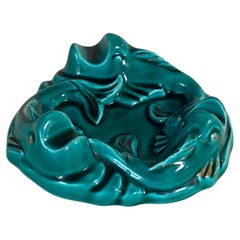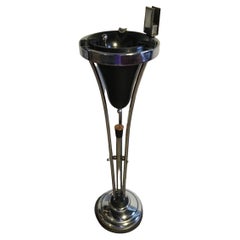Art Deco Ashtrays
Art Deco furniture is characterized by its celebration of modern life. More than its emphasis on natural wood grains and focus on traditional craftsmanship, vintage Art Deco dining chairs, tables, desks, cabinets and other furniture — which typically refers to pieces produced during the 1920s and 1930s — is an ode to the glamour of the “Roaring Twenties.”
ORIGINS OF ART DECO FURNITURE DESIGN
- Emerged in the 1920s
- Flourished while the popularity of Art Nouveau declined
- Term derives from 1925’s Exposition Internationale des Arts Décoratifs et Industriels Modernes (International Exhibition of Modern Decorative and Industrial Arts) in Paris, France
- Informed by Ancient Egypt, Cubism, Futurism, Louis XVI, De Stijl, modernism and the Vienna Secession; influenced Streamline Moderne and mid-century modernism
CHARACTERISTICS OF ART DECO FURNITURE DESIGN
- Bold geometric lines and forms, floral motifs
- Use of expensive materials such as shagreen or marble as well as exotic woods such as mahogany, ebony and zebra wood
- Metal accents, shimmering mirrored finishes
- Embellishments made from exotic animal hides, inlays of mother-of-pearl or ivory
ART DECO FURNITURE DESIGNERS TO KNOW
VINTAGE ART DECO FURNITURE ON 1STDIBS
Few design styles are as universally recognized and appreciated as Art Deco. The term alone conjures visions of the Roaring Twenties, Machine Age metropolises, vast ocean liners, sleek typography and Prohibition-era hedonism. The iconic movement made an indelible mark on all fields of design throughout the 1920s and ’30s, celebrating society’s growing industrialization with refined elegance and stunning craftsmanship.
Widely known designers associated with the Art Deco style include Émile-Jacques Ruhlmann, Eileen Gray, Maurice Dufrêne, Paul Follot and Jules Leleu.
The term Art Deco derives from the name of a large decorative arts exhibition held in Paris in 1925. “Art Deco design” is often used broadly, to describe the work of creators in associated or ancillary styles. This is particularly true of American Art Deco, which is also called Streamline Moderne or Machine Age design. (Streamline Moderne, sometimes known as Art Moderne, was a phenomenon largely of the 1930s, post–Art Nouveau.)
Art Deco textile designers employed dazzling floral motifs and vivid colors, and while Art Deco furniture makers respected the dark woods and modern metals with which they worked, they frequently incorporated decorative embellishments such as exotic animal hides as well as veneers in their seating, case pieces, living room sets and bedroom furniture.
From mother-of-pearl inlaid vitrines to chrome aviator chairs, bold and inventive works in the Art Deco style include chaise longues (also known as chaise lounges) and curved armchairs. Today, the style is still favored by interior designers looking to infuse a home with an air of luxury and sophistication.
The vintage Art Deco furniture for sale on 1stDibs includes dressers, coffee tables, decorative objects and more.
1940s French Vintage Art Deco Ashtrays
Ceramic
Mid-20th Century Belgian Art Deco Ashtrays
Chrome
1930s French Vintage Art Deco Ashtrays
Glass
Mid-20th Century European Art Deco Ashtrays
Glass
Mid-20th Century European Art Deco Ashtrays
Glass
1930s Italian Vintage Art Deco Ashtrays
Ceramic
Mid-20th Century French Art Deco Ashtrays
Ceramic, Leather
1930s American Vintage Art Deco Ashtrays
Nickel
1960s Italian Vintage Art Deco Ashtrays
Art Glass
1930s French Vintage Art Deco Ashtrays
Metal
1930s Austrian Vintage Art Deco Ashtrays
Silver, Sterling Silver
1950s Argentine Vintage Art Deco Ashtrays
Crystal
1930s American Vintage Art Deco Ashtrays
Metal
1930s French Vintage Art Deco Ashtrays
Marble, Spelter
1940s French Vintage Art Deco Ashtrays
Glass
1930s Italian Vintage Art Deco Ashtrays
Aluminum
1930s French Vintage Art Deco Ashtrays
Chrome
Mid-20th Century American Art Deco Ashtrays
Copper, Iron
1940s Italian Vintage Art Deco Ashtrays
Murano Glass
1930s American Vintage Art Deco Ashtrays
Brass, Chrome
1940s Italian Vintage Art Deco Ashtrays
Murano Glass
1940s Italian Vintage Art Deco Ashtrays
Murano Glass
1940s Italian Vintage Art Deco Ashtrays
Murano Glass
1930s French Vintage Art Deco Ashtrays
Glass
Mid-20th Century American Art Deco Ashtrays
Ceramic
Mid-20th Century Swedish Art Deco Ashtrays
Porcelain
1960s Polish Vintage Art Deco Ashtrays
Porcelain
1960s American Vintage Art Deco Ashtrays
Iron
1930s Czech Vintage Art Deco Ashtrays
Crystal
1930s Argentine Vintage Art Deco Ashtrays
Metal
Mid-20th Century American Art Deco Ashtrays
Ceramic
1930s Italian Vintage Art Deco Ashtrays
Murano Glass
1940s Italian Vintage Art Deco Ashtrays
Gold
1930s Belgian Vintage Art Deco Ashtrays
Chrome
1930s Belgian Vintage Art Deco Ashtrays
Chrome
1940s Italian Vintage Art Deco Ashtrays
Ceramic
1940s Italian Vintage Art Deco Ashtrays
Gold
1930s Italian Vintage Art Deco Ashtrays
Murano Glass
1930s Italian Vintage Art Deco Ashtrays
Murano Glass
Mid-20th Century Italian Art Deco Ashtrays
Gold Leaf
1930s French Vintage Art Deco Ashtrays
Wood
1940s Italian Vintage Art Deco Ashtrays
Murano Glass
1930s French Vintage Art Deco Ashtrays
Bronze
1940s Italian Vintage Art Deco Ashtrays
Murano Glass
1940s French Vintage Art Deco Ashtrays
Ceramic
1930s Italian Vintage Art Deco Ashtrays
Gold
1930s Italian Vintage Art Deco Ashtrays
Murano Glass
1930s Italian Vintage Art Deco Ashtrays
Murano Glass
1930s Italian Vintage Art Deco Ashtrays
Murano Glass
1930s Italian Vintage Art Deco Ashtrays
Silver, Gold
1930s Italian Vintage Art Deco Ashtrays
Murano Glass
1930s Italian Vintage Art Deco Ashtrays
Murano Glass
1930s French Vintage Art Deco Ashtrays
Crystal
1940s Italian Vintage Art Deco Ashtrays
Murano Glass
1930s Italian Vintage Art Deco Ashtrays
Murano Glass
1940s Italian Vintage Art Deco Ashtrays
Murano Glass
1940s Italian Vintage Art Deco Ashtrays
Murano Glass
1930s Italian Vintage Art Deco Ashtrays
Gold



